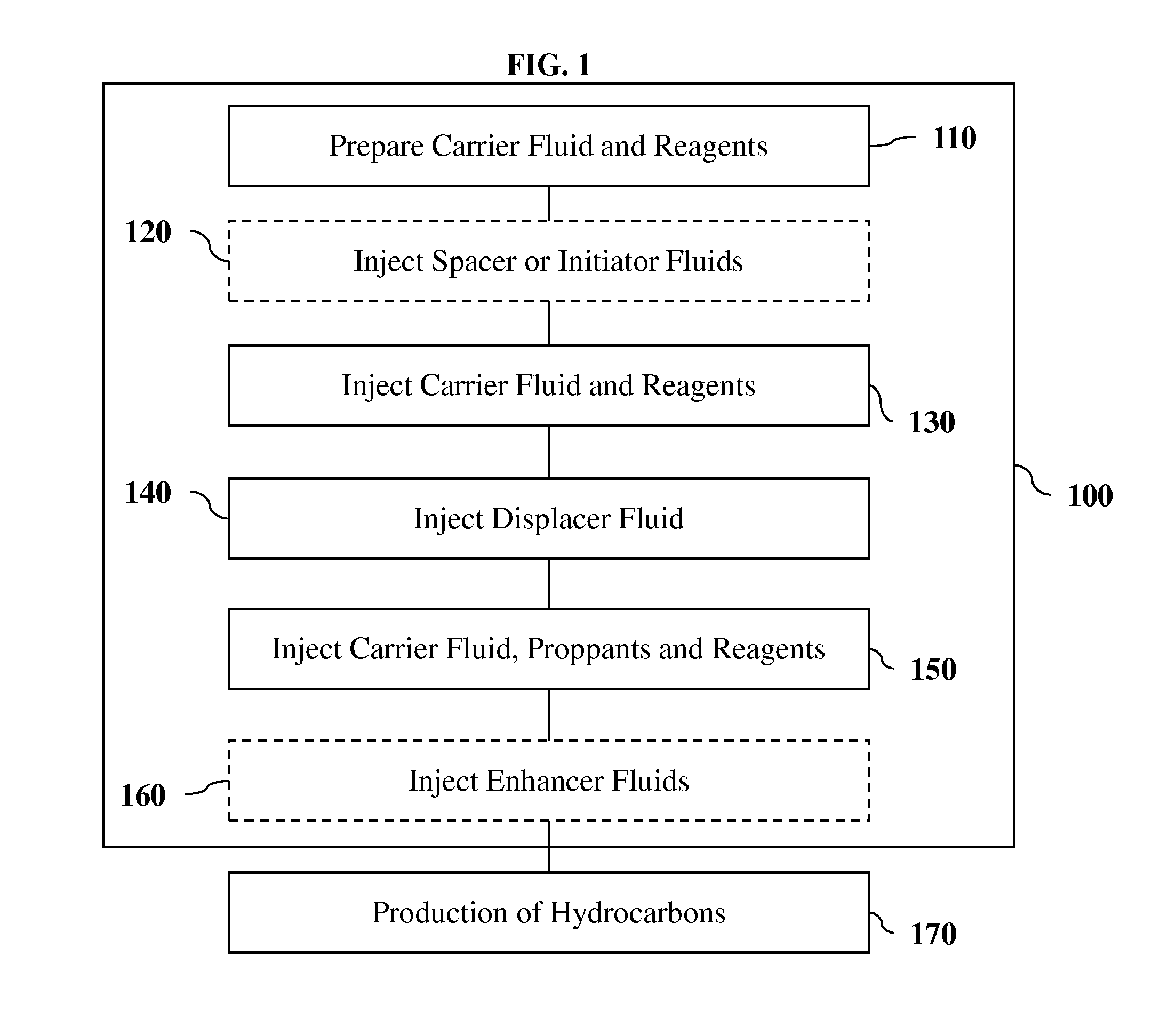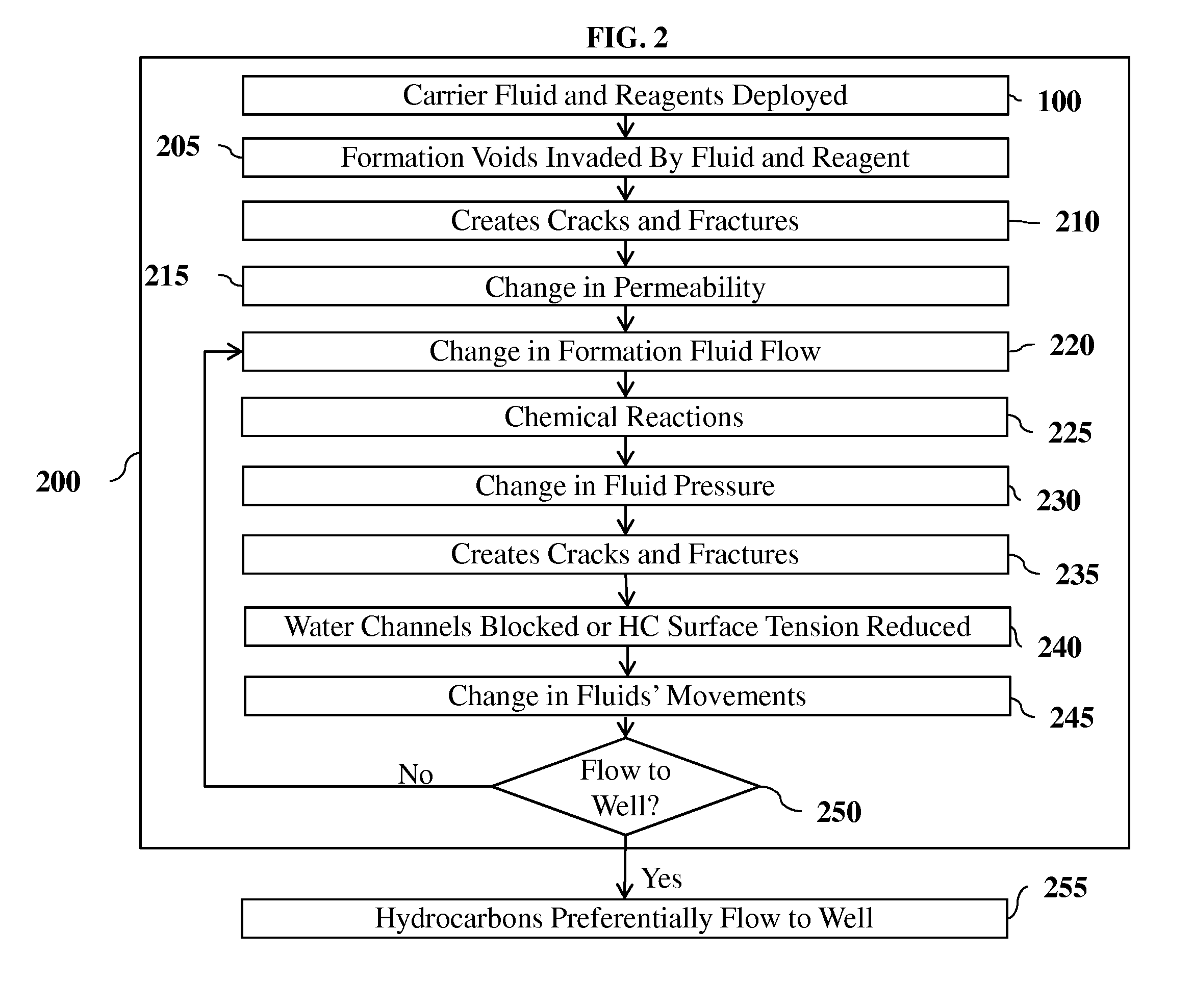Increased Resource Recovery by Inorganic and Organic Reactions and Subsequent Physical Actions that Modify Properties of the Subterranean Formation which Reduces Produced Water Waste and Increases Resource Utilization via Stimulation of Biogenic Methane Generation
a technology of inorganic and organic reactions and subterranean formations, which is applied in the direction of fluid removal, well accessories, chemistry apparatus and processes, etc., can solve the problems of fracturing the surrounding formation, unable to achieve complete radial coverage of the formation, and unable to control the propagation of fractures with increasing distance from the well, etc., to achieve the effect of facilitating the micro accumulation of gas
- Summary
- Abstract
- Description
- Claims
- Application Information
AI Technical Summary
Benefits of technology
Problems solved by technology
Method used
Image
Examples
example 1
[0117]The block diagram of FIG. 1 illustrates the steps taken to effectively and efficiently recover hydrocarbons from the subsurface using one embodiment, 100. The first step, 110, is at the surface, where a carrier fluid is prepared and the proper amounts of reagents are blended in the carrier fluid.
[0118]The reagents have some of the following attributes: a) reactive with water or a water-based solution; b) produce pressure by either a change in phase and / or the density of the solids produced are less than the density of the reagents, which in turn creates excess pressure; c) produce hydrogen gas; d) produce a water soluble anion that will selectively precipitate solids from interaction with water; e) form a solution that decreases interfacial tension of hydrocarbons which makes hydrocarbons more flowable; f) generate heat and raise both the surrounding fluids and solids temperature; and g) combinations of the above.
[0119]The reagents are preferably comprised of one or more alkal...
example 2
[0128]FIG. 2 depicts the flow chart illustrating one embodiment of the present invention 200. Method 200 starts by applying the steps in 100, deploying carrier fluids and reagents into the subsurface in the proper sequencing, volumes, rates and pressures. One such combination uses sodium metal (Na) as the reagent in liquefied petroleum gas (LPG) as the carrier fluid. Sodium has a density at 25° C. of 0.968 g·cm-3 and at 97.72° C. (melting point) a liquid density of 0.927 g·cm-3. This example describes sodium used as a liquid, although at different pressures and temperatures, sodium might be a solid. In the instance of applying this technique at subterranean conditions above the melting point of sodium, the reagent is in solution with the carrier fluid. For the purpose of brevity, this description will be focused on liquid sodium metal as the reagent, although a multitude of other combinations or reagents and their phase, chemistry and physical attributes are as or more applicable gi...
example 3
[0138]FIG. 3 depicts the flow chart illustrating one embodiment of the present invention 300. Method 300 starts by applying the steps in 100, which is deploying carrier fluids and reagents into the subsurface in the proper sequencing, volumes, rates and pressures. One such combination uses the alkaline earth magnesium (Mg) as the reagent in a water based carrier fluid that is supersaturated with CO2 gas. Magnesium has a density at 25° C. of 1.74 g·cm-3. The melting point of magnesium is 647° C. Magnesium is therefore a fairly lightweight solid. A multitude of other combinations or reagents and their phase, chemistry and physical attributes are as or more applicable given a set of conditions of the subterranean formation (permeability, capillarity, wettability, phase, composition, mineralogy, temperature, pressures etc.).
[0139]Step 305 is characterized by the voids of the formation being invaded by the carrier fluid and reagent. The fluids that were occupying that space are displaced...
PUM
 Login to View More
Login to View More Abstract
Description
Claims
Application Information
 Login to View More
Login to View More - R&D
- Intellectual Property
- Life Sciences
- Materials
- Tech Scout
- Unparalleled Data Quality
- Higher Quality Content
- 60% Fewer Hallucinations
Browse by: Latest US Patents, China's latest patents, Technical Efficacy Thesaurus, Application Domain, Technology Topic, Popular Technical Reports.
© 2025 PatSnap. All rights reserved.Legal|Privacy policy|Modern Slavery Act Transparency Statement|Sitemap|About US| Contact US: help@patsnap.com



